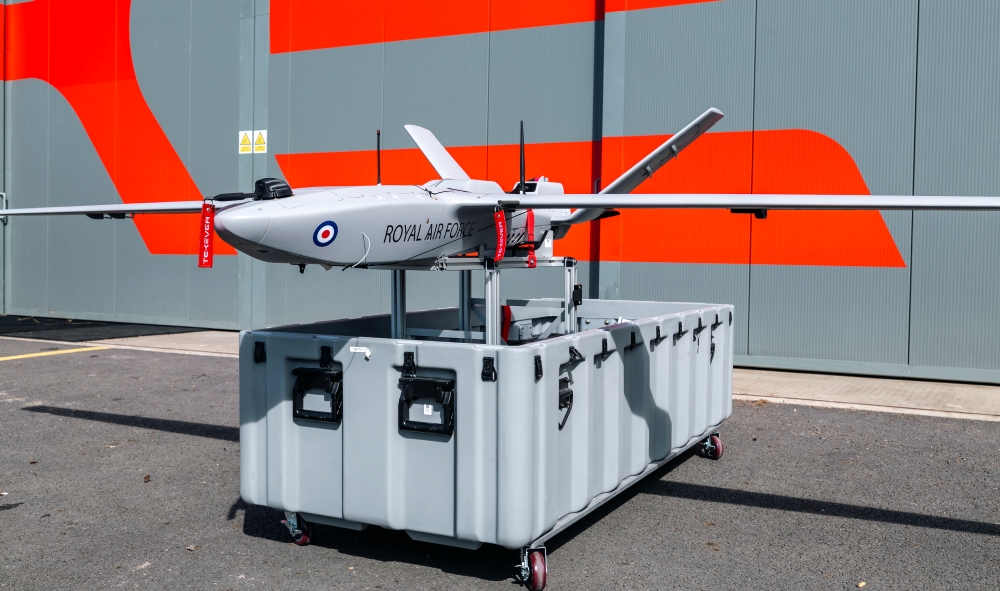
On 2 May, 216 Squadron Royal Air Force has declared initial operational capability with STORMSHROUD, the first (officially confirmed) Autonomous Collaborative Platform to enter service.
STORMSHROUD is a platform obtained by equipping the Tekever AR3 drone with the BriteStorm jammer developed by Leonardo UK. For the RAF, it is a “Tier 1”, meaning fully expendable, Autonomous Combat Platform. According to the ACP Strategy released months ago, Tier 2 are “attritable” but already more expensive and valuable platforms, with perspective Tier 3 drones being closer in value to a crewed aircraft and thus meant to be survivable.
The Tekever AR3 is manufactured in west Wales and Southampton and has been supplied to Ukraine for battlefield reconnaissance, with good results in the fields and over 10,000 hours already flown in theatre (alongside a number of larger AR5s also by Tekever). Of note, the AR3 is normally launched with a small portable catapult and lands by parachute, but Tekever also developed two swappable propeller modules that clip under the wings for Vertical Take Off and Landing, particularly useful for ship operations.
According to the RAF, 216 Squadron will be a “mixed” type of unit supported by the RAF Regiment, the close combat ground force of the RAF. The unit will comprise regulars and reserves of the Royal Auxiliary Air Force (RAuxAF), alongside other UK Defence personnel. Squadron personnel “will be trained to operate in small teams and in high threat environments”: together with the involvement of the RAF Regiment, this strongly suggests that, at least for the moment, the AR3 will continue to be primarily, if not only, launched from relatively close to the frontline. The AR3 can fly for 10 hours or more but in its base form is range-limited by the need for radio control. Greater on-board autonomy and/or different ways to relay signal to it would greatly diminish this limitation.
STORMSHROUD will support crewed TYPHOONs and F-35Bs by delivering jamming and deception of enemy radars. BriteCloud is a ‘stand-in jammer’ designed to be deployed ahead of high-value crewed combat aircraft, flying on-board small uncrewed aircraft or missiles. It suppresses and deceives an enemy’s Integrated Air Defence System (IADS), degrading their ability to find and track allied aircraft by “concealing” friendly aircraft or by creating false radar signatures on the enemy screens, mimicking the presence of real aircraft.
BriteStorm, developed and manufactured in Luton, is a further development of the technologies behind the BriteCloud active jamming decoy which has been employed on TORNADO GR4, is operational on TYPHOON and F-35 and was selected also by the USAF during 2024.
According to the Prime Minister’s Cabinet press release, the RAF is investing an initial £19 million for these drones, which are made in the UK and support 200 engineering jobs at multiple UK locations from West Wales to Somerset.
Tekever, a Portuguese company by origin, has had a growing footprint and importance in the UK for some time and, hot on the heels of the STORMSHROUD announcement, has revealed plans to invest 400 million pounds into “research, infrastructure, and defence technology development in the UK, leading to the creation of over 1000 highly-skilled jobs over the next 5 years”.
Interestingly, the Prime Minister office’s press release does not mention just the AR3, unlike the RAF’s, Leonardo UK’s and Tekever’s own releases, but also the much larger AR5 drone. This is seen as a frontrunner candidate for Project CORVUS, the programme to acquire a replacement for the British Army’s WATCHKEEPER drones. A selection for CORVUS is expected soon, with 2 h24 task lines to be delivered ideally by year end. The British Army is looking to maintain WATCHKEEPER in service until the end of March 2026 but, in case of delays, it is including one optional extra year of support for the platform in its plans.
Also worthy of note is one of the photos released by the Royal Air Force, which shows the AR3 in company with another, unnamed drone, in front of an F-35B. This second drone had been first shown to the press in March at Brize Norton during the Air and Space Power Visit. It is a one-way strike platform with a payload of 25 kg, making ample use of 3D printing to be quick to produce and inexpensive. It was apparently credited with enough range to fly from the UK to Italy.
It is not clear if this is the mysterious “AUKLET” Tier 1 drone that was already named within the Autonomous Combat Platform strategy paper released months ago. It is indicative, however, of the kind of capability 216 Squadron is supposed to field as it works on “swarm” techniques.








.png)
